Mom Follows the USS Theodore Roosevelt (CVN-71)
|
|
-EDS NOTE: CONTENTS MAY HAVE BEEN REVIEWED AS IT WAS SENT VIA NAVY COMMUNICATIONS--U.S. Navy weapons handler Tim Secrest of Murphreesboro, Tenn., watches as munitions and fuel are transferred from the USS Fighting Tiger (rear) to the aircraft carrier USS Theodore Roosevelt on Tuesday, Nov. 6, 2001. The Theodore Roosevelt was taking on supplies somewhere in the Arabian Sea. (AP Photo/Dave Martin)
|
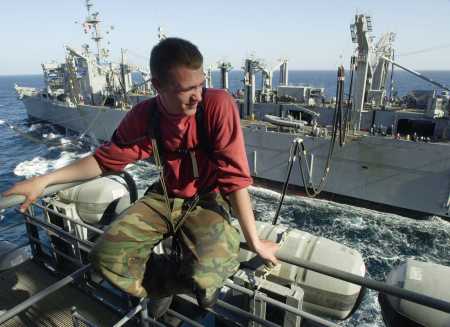 |
"Bully the Moose"
USS Theodore Roosevelt
|
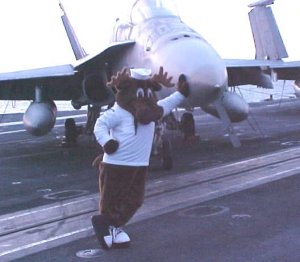 |
-EDS NOTE: CONTENTS MAY HAVE BEEN REVIEWED AS IT WAS SENT VIA NAVY COMMUNICATIONS--USS Theodore Roosevelt Commanding Officer Capt. Richard O'Hanlon talks with reporters in his stateroom aboard the aircraft carrier on Tuesday, Nov. 6, 2001. O'Hanlon was discussing the effect of strikes from his carrier on Taliban forces in Afghanistan. In background is sculpture of former President Theodore Roosevelt. (AP Photo/Dave Martin)
|
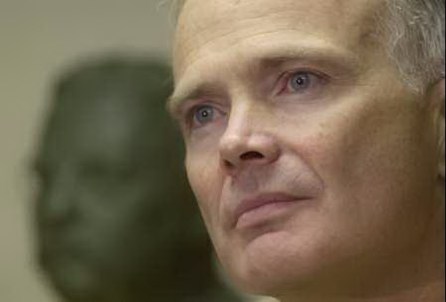 |
-EDS NOTE: CONTENTS MAY HAVE BEEN REVIEWED AS IT WAS SENT VIA NAVY COMMUNICATIONS--U.S. Navy seaman Almekdad Alameri, left, relaxes in the shade of an F/A-18C Hornet fighter during a break in flight operations aboard the aircraft carrier USS Theodore Roosevelt on Tuesday, Nov. 6, 2001. The USS Theodore Roosevelt is in the Arabian Sea in support of Operation Enduring Freedom. (AP Photo/Dave Martin)
|
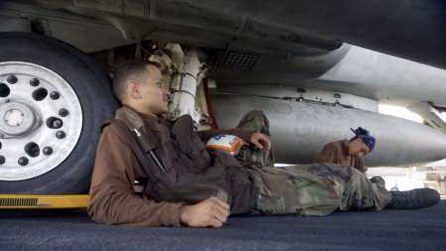 |
Captain of USS Roosevelt says war is on target, carrier can apply more pressure - By HRVOJE HRANJSKI, AP Writer
ABOARD THE USS THEODORE ROOSEVELT – The captain of this giant aircraft carrier in the Arabian Sea said Wednesday that his ship has the ability to apply more pressure on Taliban and al-Qaida targets, but the struggle won't "be won overnight."
Richard O'Hanlon dismissed criticism that the airstrikes the Roosevelt has been launching every night had achieved little, saying "anything we can find to break the backbone of the Taliban army" had been hit in Afghanistan.
"I know maybe some people at home are frustrated by perceived lack of progress, but from my point of view the progress has been substantial," O'Hanlon, a New York native, told reporters early Wednesday.
"It will take time to finally break down the fighting spirit of the Taliban to the point where we will be victorious. But leave no doubt, we will be victorious," he said.
So far the strikes had targeted terrorist training camps, military positions and cave network where Afghanistan's ruling Taliban and Osama bin Laden are believed hiding, he said. Bin Laden is the No. 1 suspect in the Sept. 11 attacks on the United States.
"We've gone after tanks, artillery pieces, armored personnel carriers, supply networks, anything we can find to break the backbone of the Taliban army," he said. "We've been pounding them day and night for weeks and weeks, affecting their morale, affecting their will to fight. But this is not going to be something that is going to be won overnight."
He said as of a few weeks ago, the U.S. fighter jets concentrated on Taliban ground forces along the front lines with the opposition northern alliance.
"There is an offensive that northern alliance has started in their push toward Mazar-e-Sharif and Kabul. The next few weeks will be very telling in how this plays out," he said. Kabul is Afghanistan's capital, and Mazar-e-Sharif a key city in the north.
Early Wednesday, the Roosevelt launched another 12-hour bombing run in Afghanistan with U.S. Navy F-14 Tomcats and Marine Corps F/A-18C Hornet attack jets. They were preceded by EA-6B Prowler surveillance planes catapulted off the flight deck.
On Tuesday, the giant carrier was resupplied with fuel and ammunition for its 76 aircraft by USNS Niagara Falls and USS Detroit.
The carrier is leading one of three U.S. battle groups in the Arabian Sea. The other two are the carriers USS Carl Vinson and the USS Kitty Hawk, which Pentagon officials have said is being used as a base for special operations troops.
O'Hanlon said the Roosevelt could still apply more pressure on the targets in Afghanistan.
"We're probably not operating at a tempo we could be operating," he said. "If we're asked to apply more pressure, we can do that. Especially with the battle force we've assembled here, there is a tremendous amount of military might yet to be untapped."
Despite the exhaustive work, the Roosevelt crew of 5,500, O'Hanlon said he expects the carrier to be back on schedule in its home port in Norfolk, Va., in March 2002.
"If we keep people and the ship on station for a very long time, we'll wear out the ship and people," he said.
AP-WS-11-06-01 1839EST
|
|
U.S. Navy seamen walk the deck of the aircraft carrier USS Theodore Roosevelt on a routine inspection for debris and foreign objects, November 6, 2001. The Navy continues strikes against the Taliban strongholds in Afghanistan. REUTERS/Dave Martin/POOL
|
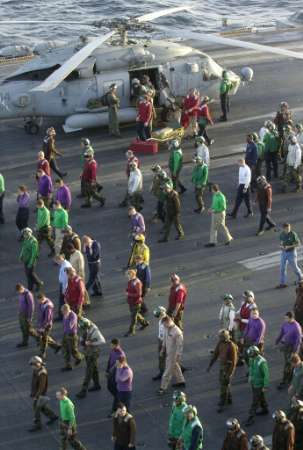 |
In this handout picture from the U.S. Navy made available Thursday, Nov. 8, 2001, Lt. j.g. Craig Hartsock from Arlington, Va., and Chief Aviation Electronics Technician (AW) James Hamlin of Michigan Center, Mich., inside the flight deck control aboard USS Theodore Roosevelt, prepare aircraft movement on the flight deck for the first two air-launch strikes of the day Tuesday, Nov. 6, 2001. The Theodore Roosevelt is operating in support of Operation Enduring Freedom. (AP Photo/U.S. Navy, Johnny Bivera)
|
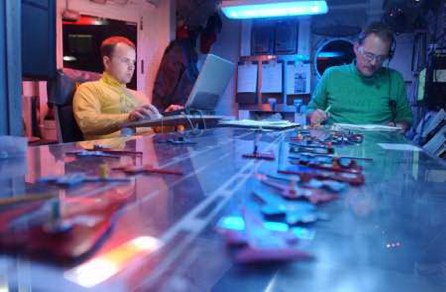 |
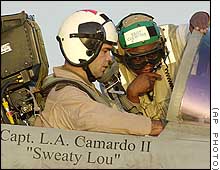 |
A U.S. Marine pilot confers with an aircraft maintenance sergeant in the cockpit of his F/A-18C Hornet fighter on the deck of the aircraft carrier USS Theodore Roosevelt on Wednesday. November 7, 2001 Posted: 8:08 a.m. EST (1308 GMT)
|
-EDS NOTE: CONTENTS MAY HAVE BEEN REVIEWED AS IT WAS SENT VIA NAVY COMMUNICATIONS--U.S. Marine aircraft maintenance crews from VMFA-251 Thunderbolt Squadron normally stationed at Beaufort, SC., take a few minutes to read letters from school children sent to them from the United States on Wednesday, Nov. 7, 2001. Holding the drawing is Cpl. "Cumba", 28 of Puereto Rico. The Marines maintain F/A-18C attack fighters aboard the aircraft carrier USS Theodore Roosevelt in the Arabian Sea. (AP Photo/Dave Martin)
|
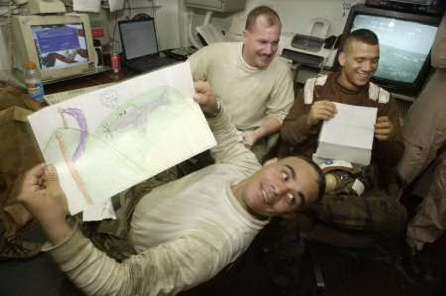 |
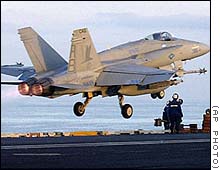 A U.S. warplane takes off from the deck of the USS Roosevelt.
|
By the numbers
Figures related to the U.S.-led campaign in Afghanistan (estimates as of early Nov.)
Sorties flown: 2,300
Reservists recalled: 43,600
Rations dropped: 1.2 million
Primary targets: Kabul (26 strikes), Kandahar (23), Mazar-e Sharif (13)
U.S. casualties: 3
U.S. radio broadcasts in Afghanistan: 300+ hours
Source: U.S. Defense Dept.
|
In this handout photo from the U.S. Navy, aviation ordnancemen perform final maintenance checks on 1000-pound laser-guided bombs on an F/A-18 Hornet prior to flight operations Tuesday, Nov. 6, 2001, aboard the USS Theodore Roosevelt in the Arabian Sea. The Roosevelt is launching airstrikes against targets in Afghanistan. (AP Photo/U.S. Navy, Dennis Taylor)
|
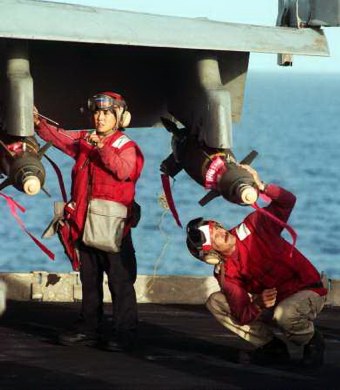 |
EDS NOTE: CONTENTS MAY HAVE BEEN REVIEWED AS IT WAS SENT VIA NAVY COMMUNICATIONS--A U.S. Navy aircraft maintenance seaman cleans the canopy of a F/A-18C Hornet attack fighter prior to launch on a strike mission in Afghanistan from the deck of the USS Theodore Roosevelt Thursday, Nov. 8, 2001, in the Arabian Sea. (AP Photo/Dave Martin)
|
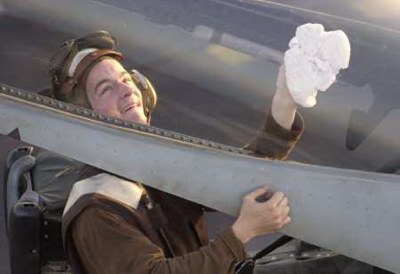 |
EDS NOTE: CONTENTS MAY HAVE BEEN REVIEWED AS IT WAS SENT VIA NAVY COMMUNICATIONS--Crew members of the USS Theodore Roosevelt cheer as they watch a closed circuit broadcast to the crew of successful bombing runs against Taliban targets in Afghanistan Friday, Nov. 9, 2001. The footage they watched was shot by Navy and Marine pilots making the runs from the aircraft carrier operating in the Arabian Sea. The seaman wearing the red shirts prepare the bombs that are loaded on the aircraft. (APPhoto/Dave Martin)
|
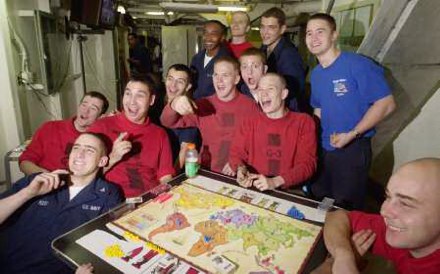 |
Pakistan's Dawn newspaper reported on November 10, 2001 that in an interview from inside Afghanistan, Osama bin Laden said he had nuclear and chemical weapons and might use them to respond to U.S. attacks. The paper said that when asked where he got the weapons from, bin Laden replied: ``Go to the next question.'' Bin Laden is seen during a videotaped statement broadcast Nov. 3. (Al-Jazeera TV via Reuters)
|
 |
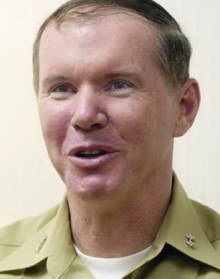 |
--EDS NOTE: PHOTO MAY HAVE BEEN REVIEWED AS IT WAS SENT VIA NAVY COMMUNICATIONS -- Commander of the Theodore Roosevelt Battle Group Rear Adm. Mark P. Fitzgerald talks with reporters aboard the aircraft carrier USS Theodore Roosevelt on Saturday, Nov. 10, 2001. (AP Photo/Dave Martin, Pool)
(Aboard the USS Theodore Roosevelt, November 9th, 2001, 7:20 a.m.) The commander of the Norfolk-based USS Theodore Roosevelt battle group says the U.S. air campaign is paving the way for the Afghan people to overthrow the Taliban.
Rear Admiral Mark Fitzgerald says every day of the past week, U.S. warplanes have been knocking out Taliban armor, tanks and armored personnel carriers, as well as key mortar, artillery and machine-gun positions.
He says the Taliban forces have suffered a number of defections. Fitzgerald spoke from aboard the Roosevelt. He's leading one of three battle groups in the Arabian Sea. (Copyright 2001 by The Associated Press. All Rights Reserved.)
|
EDS NOTE: CONTENTS MAY HAVE BEEN REVIEWED AS IT WAS SENT VIA NAVY COMMUNICATIONS--A U.S. Navy aircraft safety observer leans on the nose of a F/A-18C Hornet in the early morning light aboard the USS Theodore Roosevelt Saturday, Nov. 10, 2001, in Arabian Sea. (AP Photo/Dave Martin, Pool)
|
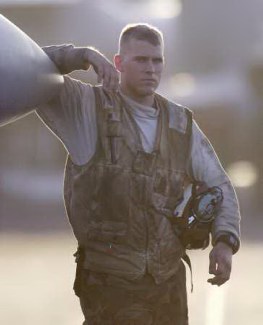 |
EDS NOTE: CONTENTS MAY HAVE BEEN REVIEWED AS IT WAS SENT VIA NAVY COMMUNICATIONS--U.S. Navy "Shooter" Lt. Bill Schlemmer of Coeur d'Alene, Idaho signs a message on a Mark 83 general purpose 1,000 pound bomb on the deck of the USS Theodore Roosevelt Saturday, Nov. 10, 2001. Schlemmer signed the name of a friend, Lt. Scott Lamana, who was killed in the terrorist attack on the Pentagon Sept. 11th. (AP Photo/Dave Martin, Pool)
|
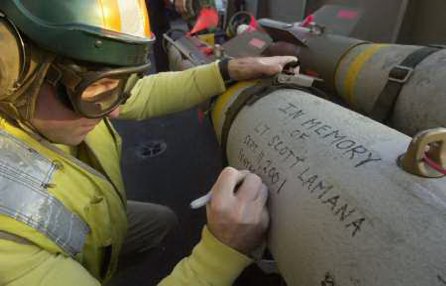 |
Saturday, Nov. 10 10:08 AM ET Taliban Acknowledge Losing Key City By KATHY GANNON, Associated Press Writer
KABUL, Afghanistan (news - web sites) (AP) - The Taliban acknowledged Saturday that they lost the city of Mazar-e-Sharif, and an opposition commander said an attack on the capital, Kabul, would start within days.
Following the capture of Mazar-e-Sharif, an opposition commander, Mohammed Mohaqik, said anti-Taliban forces quickly seized three northern provincial capitals - Shibarghan in Jozjan province; Aybak in Samangan province; and Maimana in Faryab province.
There was no comment from the Taliban on the opposition claims, and no foreign reporters were in the area. However, taking Aybak would cut the main escape route for Taliban soldiers withdrawing from Mazar-e-Sharif to Kabul.
If the other northern towns have also fallen, the Taliban may be abandoning large swaths of territory populated by ethnic minorities and redeploying their forces to defend Kabul and other strongholds of the dominant Pashtun ethnic group.
``This morning the city is quiet,'' said Karim Khalili, spokesman for the Shiite Muslim opposition, said of Mazar-e-Sharif. ``There is no fighting. All the Taliban are gone.''
The capture of Mazar-e-Sharif was the biggest success since President Bush (news - web sites) launched airstrikes Oct. 7 to force the Taliban to hand over Osama bin Laden (news - web sites), chief suspect in the Sept. 11 terrorist attacks on the United States.
With Mazar-e-Sharif in opposition hands, the U.S.-led coalition can open a land bridge to Uzbekistan, 45 miles to the north, to rush in humanitarian goods and military supplies to anti-Taliban forces.
Mazar-e-Sharif also has a large airport that could be refurbished for American and allied aircraft to conduct humanitarian missions and mount attacks against the Taliban from within Afghanistan.
Following the Taliban withdrawal from the city, opposition officials said hundreds of Arab and Pakistani volunteers fighting with the Islamic militia had holed up in a school six miles west of Mazar-e-Sharif.
Mohaqik of the opposition Shiite faction said anti-Taliban forces overran the school, captured 50 Pakistanis and Arabs and killed another 1,000 of them. Earlier another Shiite Muslim spokesman Saeed Zaher Wasik said the opposition wanted to take the captives alive.
The report could not be confirmed, and the Taliban denied it. Abdul Hanan Hemat, chief of the Taliban-controlled Bakhtar News Agency, said ``there are no troops under siege and that the bulk of the Taliban forces had withdrawn to Samangan province east of Mazar-e-Sharif.
Hemat also said the Taliban withdrew from Mazar-e-Sharif under orders from the Defense Ministry to save the soldiers and the city.
``We did not want to risk our soldiers or have the city destroyed, so we left,'' he said. ``But our morale is high. Losing Mazar-e-Sharif has not damaged our spirit.''
He said the opposition would have been unable to take the city had it not been for a week of relentless bombing by U.S. jets.
The various reports could not be confirmed, because no foreign reporters have been allowed near Mazar-e-Sharif.
The fall of the strategic city boosted opposition morale on the other main front, about 30 miles north of Kabul. Alim Khan, a northern alliance commander there, said an attack on the city was to start within three days and that 1,000 opposition troops planned to assemble Sunday at Bagram, site of an opposition-controlled air base near the front line.
In Washington, Secretary of State Colin Powell (news - web sites) told reporters it would be best if the opposition did not move immediately toward Kabul, since the city's population is likely to be hostile to it.
Meanwhile, American B-52 bombers and other warplanes attacked north of Kabul on Saturday, and enormous clouds of smoke billowed skyward from Taliban positions.
Capitalizing on their victory, anti-Taliban troops also took control of Hairatan on the Afghan border with Uzbekistan, said Mohammed Abil, a spokesman for Burhanuddin Rabbani, the titular head of the Afghan opposition.
Abil said opposition soldiers had also taken Taliban mountaintop positions overlooking Taloqan, the capital of northeast Takhar province and the headquarters of the anti-Taliban alliance until it fell to Taliban troops in September 2000.
The residents of Mazar-e-Sharif warmly greeted triumphant alliance fighters when they entered the city, said Mohammed Hasham Saad, the top opposition official in Uzbekistan. Most people in the city, along with the majority of northern alliance soldiers, are ethnic Tajiks and Uzbeks.
``They helped our forces move inside of the city and gave them food and information,'' Saad said. Some civilians pointed out Taliban positions to alliance fighters, he said.
He said Radio Mazar-e-Sharif had begun broadcasting and that one of the first messages to the people was from Rabbani, the former Afghan president who was ousted by the Taliban in 1996.
In Dushanbe, Tajikistan, the northern alliance's foreign minister, Abdullah, said the Taliban had left 20 tanks and many heavy weapons behind. At least 20 Taliban fighters were killed and hundreds were taken prisoner, he said.
Anti-Taliban troops at the front were cheered by the news of the fall of Mazar-e-Sharif, which changed hands several times in the late 1990s and was the site of massacres. Villagers crowded around transistor radios to hear the latest news.
``This is the beginning of the collapse of the Taliban,'' said Nur Agha, a 22-year-old fighter.
Mohammad Afzal Amon, the commander of the opposition's elite Zarbati troops north of Kabul, said 600 troops had been sent to his area since the victory in Mazar-e-Sharif.
|
|
-EDS NOTE: CONTENTS MAY HAVE BEEN REVIEWED AS IT WAS SENT VIA NAVY COMMUNICATIONS--A U..S. Marine crewmember takes a photo of a cake baked in honor of the Marines' 226th birthday during a special breakfast served to the personnel aboard the USS Theodore Roosevelt on Saturday, Nov. 10, 2001. The Marines aboard the carrier are with the VMFA-251 Thunderbolt Squadron from Charleston, SC. (AP Photo/Dave Martin, Pool)
|
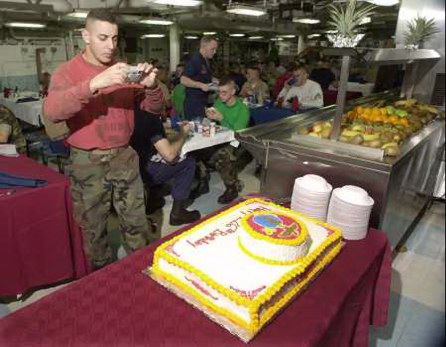 |
-EDS NOTE: PHOTO MAY HAVE BEEN REVIEWED AS IT WAS SENT VIA NAVY COMMUNICATIONS--U.S. Marine Corp Lt. Col. "Squeeze" talks with reporters aboard the aircraft carrier USS Theodore Roosevelt in the Arabian Sea on Saturday, Nov. 10, 2001. The officer is the squadron commander of the VMFA-251 Thunderbolt Squadron normally stationed near Charleston, S.C. (AP Photo/Dave Martin, Pool)
|
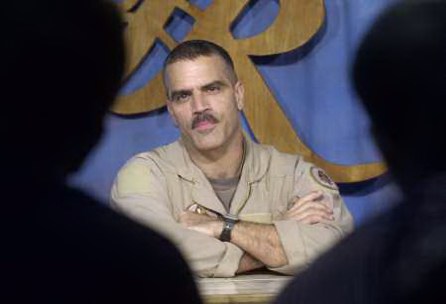 |
-EDS NOTE: PHOTO MAY HAVE BEEN REVIEWED AS IT WAS SENT VIA NAVY COMMUNICATIONS--U.S. Marine Corp pilot "Simple", left, and another pilot, aboard the aircraft carrier USS Theodore Roosevelt, gear up in the Thunderbolts equipment room for their mission over Afghanistan on Sunday, Nov. 11, 2001. The pilots are members of the VMFA-251 Thunderbolt Squadron normally stationed near Charleston, S.C. (AP Photo/Dave Martin, Pool)
|
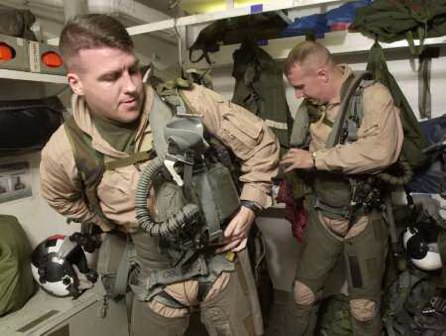 |
EDS NOTE: CONTENTS MAY HAVE BEEN REVIEWED AS IT WAS SENT VIA NAVY COMMUNICATIONS--A U.S. Navy aircraft maintenance crewman carries an oil bowser on his back as he prepares to service a F/A-18C Hornet on the deck of the USS Theodore Roosevelt in the Arabian Sea Sunday, Nov. 11, 2001. An oil bower is used to top up the oil in the fighters. (AP Photo/Dave Martin, Pool)
|
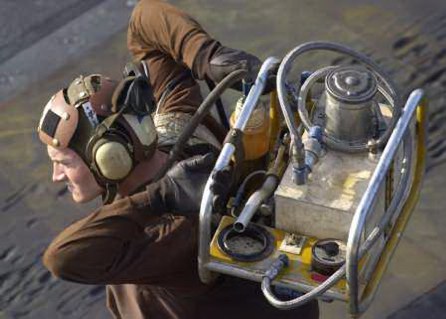 |
EDS NOTE: CONTENTS MAY HAVE BEEN REVIEWED AS IT WAS SENT VIA NAVY COMMUNICATIONS--U.S. Navy seamen participate in a chemical decontamination drill on the USS Theodore Roosevelt in the Arabian Sea Monday, Nov. 12, 2001. The drills are held often to test the readiness and preparation of the crew. (AP Photo/Dave Martin, Pool)
|
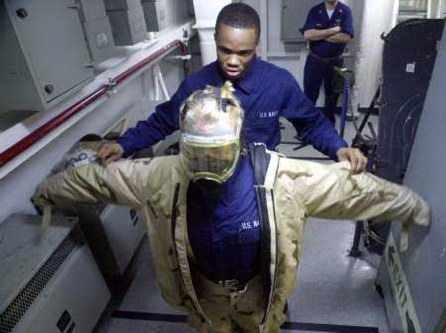 |
-EDS NOTE: CONTENTS MAY HAVE BEEN REVIEWED AS IT WAS SENT VIA NAVY COMMUNICATIONS--U.S. Navy seamen watch television during a chemcial attack drill on the USS Theodore Roosevelt in the Arabian Sea on Monday, Nov. 12, 2001. The drills are held often to test the readiness and preparation of the crew. (AP Photo/Dave Martin)
|
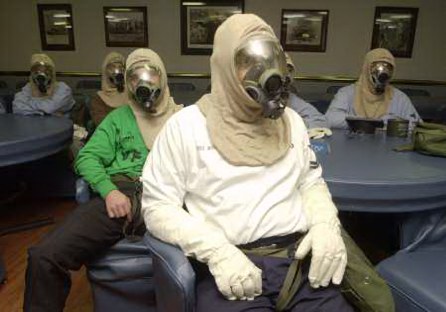 |
-EDS NOTE: CONTENTS MAY HAVE BEEN REVIEWED AS IT WAS SENT VIA NAVY COMMUNICATIONS--U.S. Navy seamen Steven Perry, left, of Detroit, Cornelius Frazier of Kansas City, MO., and Mel Comer, of Detroit, right, lean on a F/A-18C Hornet attack fighter in the hanger deck of the USS Theodore Roosevelt in the Arabian Sea on Monday, Nov. 12, 2001. The seamen were wearing gas masks during a chemical attack drill. (AP Photo/Dave Martin)
|
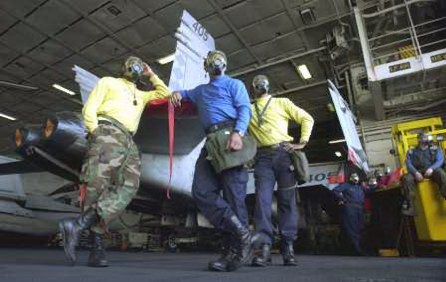 |
|
|
|